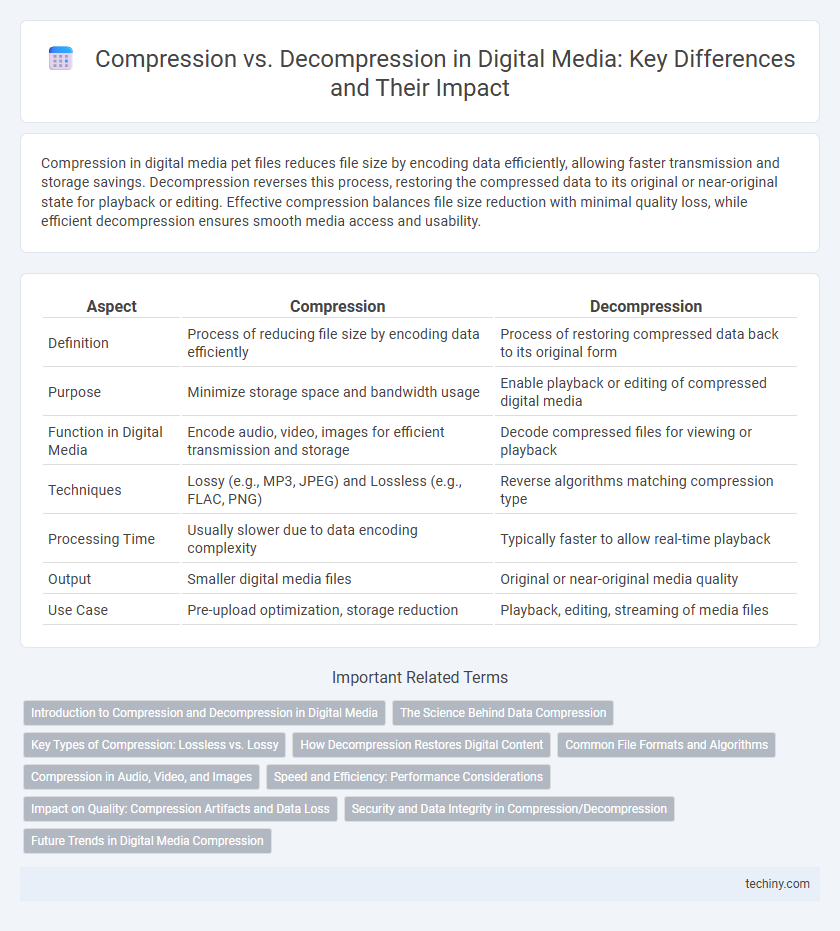Compression in digital media pet files reduces file size by encoding data efficiently, allowing faster transmission and storage savings. Decompression reverses this process, restoring the compressed data to its original or near-original state for playback or editing. Effective compression balances file size reduction with minimal quality loss, while efficient decompression ensures smooth media access and usability.
Table of Comparison
| Aspect | Compression | Decompression |
|---|---|---|
| Definition | Process of reducing file size by encoding data efficiently | Process of restoring compressed data back to its original form |
| Purpose | Minimize storage space and bandwidth usage | Enable playback or editing of compressed digital media |
| Function in Digital Media | Encode audio, video, images for efficient transmission and storage | Decode compressed files for viewing or playback |
| Techniques | Lossy (e.g., MP3, JPEG) and Lossless (e.g., FLAC, PNG) | Reverse algorithms matching compression type |
| Processing Time | Usually slower due to data encoding complexity | Typically faster to allow real-time playback |
| Output | Smaller digital media files | Original or near-original media quality |
| Use Case | Pre-upload optimization, storage reduction | Playback, editing, streaming of media files |
Introduction to Compression and Decompression in Digital Media
Compression reduces digital media file sizes by encoding data more efficiently, enabling faster transmission and saving storage space. Decompression reconstructs the original media from compressed data, ensuring playback quality remains intact for audio, video, and image files. Effective compression algorithms balance file size reduction with maintaining high fidelity in digital content.
The Science Behind Data Compression
Data compression relies on algorithms that reduce file size by eliminating redundancies within digital media, leveraging techniques such as lossless methods like Huffman coding and lossy methods like transform coding. Decompression reverses this process, reconstructing the original data by decoding compressed streams through mathematical models and entropy coding. Understanding the balance between compression ratio and data fidelity is crucial for optimizing storage efficiency and playback quality in digital media applications.
Key Types of Compression: Lossless vs. Lossy
Lossless compression preserves the original data by encoding information efficiently, making it ideal for text files, software, and high-quality images where exact replication is essential. Lossy compression reduces file size by permanently eliminating some data, commonly used in digital media formats like JPEG, MP3, and MP4 to balance quality and storage requirements. Understanding these key types of compression is crucial for optimizing digital media workflows, as lossless ensures fidelity while lossy enhances bandwidth and storage efficiency.
How Decompression Restores Digital Content
Decompression reverses the compression process by reconstructing the original digital content from a compressed file, restoring the data to its usable form. This involves decoding algorithms that expand compressed bits back into pixels, audio waves, or video frames, preserving the integrity and quality of the media. Efficient decompression techniques ensure minimal loss and fast retrieval, enabling seamless playback and editing of digital media files.
Common File Formats and Algorithms
Compression and decompression are fundamental processes in digital media, involving algorithms like Huffman coding, LZW, and Run-Length Encoding to reduce file sizes for formats such as JPEG, MP3, and MP4. Lossy compression techniques, used in JPEG and MP3, discard non-essential data to optimize storage, while lossless algorithms like PNG and FLAC preserve original quality during decompression. Efficient encoding and decoding balance fidelity and file size, enabling faster transmission and playback across diverse media platforms.
Compression in Audio, Video, and Images
Audio, video, and image compression reduce file sizes by eliminating redundancies and encoding data more efficiently, improving storage and transmission speeds across digital media platforms. Compression algorithms such as MP3 for audio, H.264 for video, and JPEG for images use lossy or lossless techniques that balance quality and bandwidth requirements. Effective compression enhances streaming performance, reduces latency, and supports scalable content delivery in multimedia applications.
Speed and Efficiency: Performance Considerations
Compression algorithms optimize data size reduction by balancing speed and efficiency, with faster algorithms like LZ4 favoring rapid compression but potentially larger file sizes. Decompression typically prioritizes speed to ensure quick data retrieval, as seen in codecs like MPEG-4, which streamline playback performance by minimizing latency. Evaluating performance requires assessing the specific use case, such as real-time streaming or archival storage, to choose the optimal trade-off between compression ratio and processing speed.
Impact on Quality: Compression Artifacts and Data Loss
Compression reduces file size by removing redundant or non-essential data, which can introduce visible compression artifacts such as blockiness, blurring, and color banding that degrade image and video quality. Decompression reconstructs the original media but often cannot perfectly restore lost data, resulting in permanent quality loss, especially in lossy compression formats like JPEG and MP3. The balance between compression ratio and quality preservation is critical for maintaining acceptable visual and auditory experiences in digital media applications.
Security and Data Integrity in Compression/Decompression
Compression algorithms enhance digital media security by reducing data redundancy, which minimizes potential attack vectors during storage and transmission. Decompression ensures data integrity by accurately reconstructing the original media file, preventing corruption or unauthorized alterations. Advanced encryption integrated with compression techniques further safeguards compressed files against tampering and unauthorized access.
Future Trends in Digital Media Compression
Emerging AI-driven algorithms are revolutionizing digital media compression by achieving higher efficiency with reduced data loss, enabling faster streaming and lower bandwidth consumption. Edge computing integration enhances real-time decompression, supporting ultra-high-definition content delivery on mobile devices with minimal latency. Future trends emphasize adaptive compression techniques that dynamically adjust to network conditions, optimizing user experience in diverse digital environments.
Compression vs Decompression Infographic

 techiny.com
techiny.com